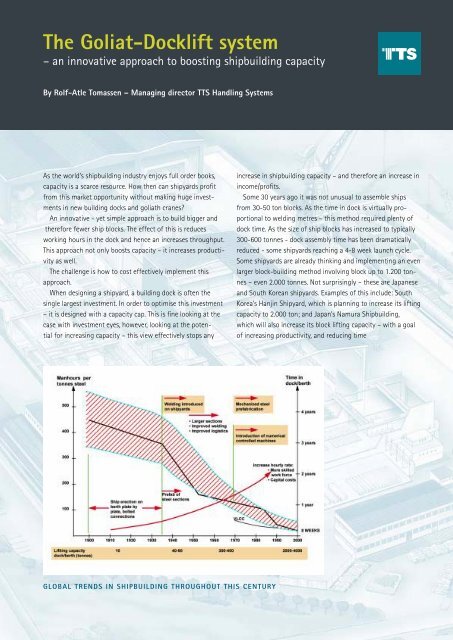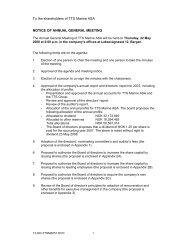The Goliat-Docklift system - TTS Group ASA
The Goliat-Docklift system - TTS Group ASA
The Goliat-Docklift system - TTS Group ASA
You also want an ePaper? Increase the reach of your titles
YUMPU automatically turns print PDFs into web optimized ePapers that Google loves.
<strong>The</strong> <strong>Goliat</strong>-<strong>Docklift</strong> <strong>system</strong><br />
– an innovative approach to boosting shipbuilding capacity<br />
By Rolf-Atle Tomassen – Managing director <strong>TTS</strong> Handling Systems<br />
As the world’s shipbuilding industry enjoys full order books,<br />
capacity is a scarce resource. How then can shipyards profi t<br />
from this market opportunity without making huge investments<br />
in new building docks and goliath cranes?<br />
An innovative - yet simple approach is to build bigger and<br />
therefore fewer ship blocks. <strong>The</strong> effect of this is reduces<br />
working hours in the dock and hence an increases through put.<br />
This approach not only boosts capacity – it increases productivity<br />
as well.<br />
<strong>The</strong> challenge is how to cost effectively implement this<br />
approach.<br />
When designing a shipyard, a building dock is often the<br />
single largest investment. In order to optimise this investment<br />
– it is designed with a capacity cap. This is fi ne looking at the<br />
case with investment eyes, however, looking at the potential<br />
for increasing capacity – this view effectively stops any<br />
GLOBAL TRENDS IN SHIPBUILDING THROUGHOUT THIS CENTURY<br />
increase in shipbuilding capacity – and therefore an increase in<br />
income/profi ts.<br />
Some 30 years ago it was not unusual to assemble ships<br />
from 30-50 ton blocks. As the time in dock is virtually proportional<br />
to welding metres – this method required plenty of<br />
dock time. As the size of ship blocks has increased to typically<br />
300-600 tonnes - dock assembly time has been dramatically<br />
reduced - some shipyards reaching a 4-8 week launch cycle.<br />
Some shipyards are already thinking and implementing an even<br />
larger block-building method involving block up to 1.200 tonnes<br />
– even 2.000 tonnes. Not surprisingly – these are Japanese<br />
and South Korean shipyards. Examples of this include: South<br />
Korea’s Hanjin Shipyard, which is planning to increase its lifting<br />
capacity to 2.000 ton; and Japan’s Namura Shipbuilding,<br />
which will also increase its block lifting capacity – with a goal<br />
of increasing productivity, and reducing time
<strong>The</strong> <strong>Goliat</strong>-<strong>Docklift</strong> <strong>system</strong><br />
in dock from 29 to 21 days, hence increasing the number of<br />
ships built each year from 8 to 12.<br />
One of the reasons to why this has not been done to a<br />
greater extent – is the cost of getting the necessary 1.200 or<br />
2.000 tonnes lifting capacity. Technology such as the goliath<br />
crane – has its optimum working range. Imagine the cost<br />
of a 2.000 tonnes goliath crane spanning some 140 metres.<br />
Another reason is probably the general shipyard conservative<br />
view of new technology.<br />
When increasing a shipyard’s capacity by utilising block<br />
building weighing 1.200-2.000 tonnes, the <strong>Goliat</strong> <strong>Docklift</strong><br />
concept is the only cost viable alternative.<br />
<strong>The</strong> concept comprises a <strong>Docklift</strong> and a heavy load/fl exible<br />
fl uid bed transporter – a Dual Walking Beam (DWB).<br />
<strong>The</strong> DWB transporters, which have lifting capacities of 100,<br />
200 and 400 tons units, transport the block from the block<br />
assembly area to the building dock and the <strong>Goliat</strong> <strong>Docklift</strong>.<br />
<strong>The</strong> <strong>Goliat</strong> <strong>Docklift</strong>, which is similar in operation to shiplifts,<br />
then lowers the block into the building dock.<br />
From here – the DWB walks the block to the ship and<br />
accurately positions the block in six axes.<br />
<strong>The</strong> <strong>system</strong> has already made its mark in a few shipyards – the<br />
largest installation being at Zaliv Shipyard, Ukraine. Here <strong>TTS</strong><br />
has delivered a 2.000 tonne capacity <strong>Docklift</strong> and 10 DWBs of<br />
200 tonne capacity each. Meanwhile, France’s largest naval<br />
shipyard, DCAN, Cherbourge has a total of 38 DWBs of up to<br />
400 tonnes capacity each. Other shipyards using <strong>TTS</strong> DWBs<br />
as part of the production <strong>system</strong>, include the Norwegian<br />
ship yards – Bomek, Ulstein, Kvaerner Fjellstrand, Kvaerner<br />
Mandal, and Sterkoder, Bazan (Spain), Kvaerner (Singapore)<br />
and Marinette Marine (US).<br />
<strong>The</strong> DWB can transport blocks – or if necessary complete ships.<br />
<strong>The</strong> <strong>Goliat</strong> <strong>Docklift</strong> – inside the building dock














![2012.MasterPresentation_final [Compatibility Mode] - TTS Group ASA](https://img.yumpu.com/4612021/1/190x146/2012masterpresentation-final-compatibility-mode-tts-group-asa.jpg?quality=85)


